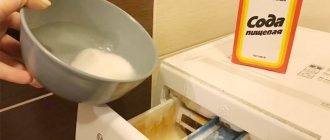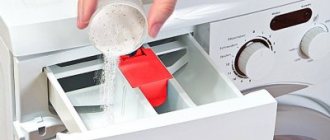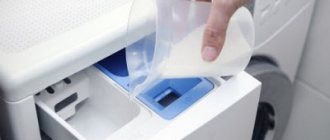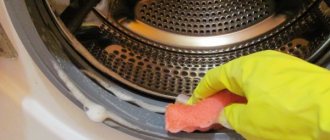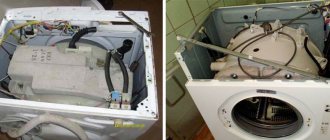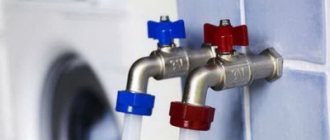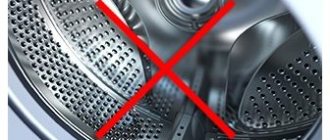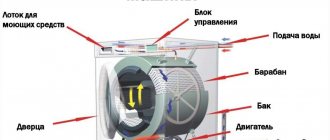Automatic machine washing involves placing items in the drum, making settings, and adding detergent.
The safety of the working components of the device and the quality of the washing process itself depend on how correctly this is done.
Is it possible to pour powder directly into the drum of an automatic washing machine, how can this be dangerous? Let's try to figure it out.
Is it permissible?
When the operating cycle starts, the washing machine begins to supply water under pressure into the cuvette. Then it goes into the drum.
Regardless of the presence or absence of detergent in the compartment, the operating procedure of the automatic machine does not change. The functionality of the device itself is not radically affected by where the powder is placed .
If the dry mixture was poured into the cuvette before washing, then the pressure of water not only washes it off into the laundry, but also dissolves all particles. Otherwise, when the powder was poured directly into the drum, the incoming water begins to dissolve it only as it accumulates.
At the same time, there remains the danger that previously undissolved granules can give an unexpected reaction on things - leaving stains.
An even greater danger is the addition of stain removers and bleaches into the drum . These are aggressive agents that can not only leave stains on the laundry, but even ruin the fabric.
Manufacturers of household chemicals do not recommend pouring the product directly into the drum of a washing machine.
Is it possible to pour powder into the drum?
Some overly active housewives can find a bunch of shortcomings in each device that they strive to correct with all their might. For example, a standard detergent bath has several disadvantages:
- Contaminants accumulate on the inner surface over time;
- SMS particles stick to the tray and are quite difficult to get rid of;
- If you don't take care of the bath, it begins to emit unpleasant odors.
Therefore, it may seem that using SMS directly in the drum has only advantages:
- Saving. The powder gets directly onto things, so it has a stronger effect on the fabric.
- The bathtub and internal elements of the “washing machine” remain clean. Particles of the substance do not come into contact with the bath and do not stick to its surface. This means that no unpleasant odors will appear over time.
In reality, this use has minimal benefits. In standard use, SMS is rinsed out of the bath under pressure, so it dissolves more quickly in the water. This means washing is more efficient. You don't have to wait for the product to dissolve in the drum. In addition, if you pour SMS inside the drum, you will have to increase the washing time in order to achieve a high-quality result. And this entails an increase in the use of water and electricity.
In what cases is this the norm?
In some cases, placing the product directly on clothing is not only acceptable, but also the only possible option. These are exceptions to the general rule.
Capsules
Capsules in the form of pads are produced by many manufacturers of household chemicals. This product is intended for automatic processing only.
Application of capsules:
- Place 1 capsule per standard load into an empty drum.
- Place laundry on top.
- Set the processing mode.
- Start the wash cycle.
Any other method of using capsules is unacceptable.
Soap powder
If the soap powder designed for automatic processing is coarse-grained, it is better not to pour it into the cuvette. Upon contact with water, such a composition will become viscous, and may not be completely washed out and not reach the laundry.
For better dissolution of soap-based mixtures, it is advisable to first dilute them with water and put them in the drum in this form.
Gel
Powder in liquid form can be not only poured into a cuvette, but also placed directly into a drum . Since the product is homogeneous, without grains or granules, the option of pouring it directly onto clothing is acceptable.
If the gel is poured directly into the drum, then it is advisable to start the wash cycle immediately, without delay. This will prevent the undiluted product from contacting the laundry for a long time.
This article will tell you where to put washing gel in the washing machine.
Other options
If necessary, it is also possible to place mild, plant-based detergents into the drum. also permissible to include drugs sold in compressed form .
Where to pour liquid powder into the washing machine
Liquid household chemicals are becoming increasingly popular among modern housewives. This is not surprising, because it has a number of undeniable advantages:
- is a concentrated SMS;
- economical;
- you don’t have to wait long for it to dissolve in water;
- completely rinses out of laundry;
- suitable for caring for delicate fabrics;
- does not remain on the walls of the tray.
However, not everyone can immediately figure out where liquid SMS should be poured, because “washing machines” do not have a special compartment for this. But you can’t pour them into the rinse aid compartment - the product will get into the laundry only during conditioning. Let's look at how to use gel-like substances.
- Special department. The most modern SMA models are adapted for the use of gel detergents. Therefore, their design provides a special, most often plug-in compartment. It looks like a small container equipped with an overflow valve. It is important not to fill the gel above the indicated level. Otherwise it will go straight into the drum.
- Special curtains. You can find transition machines on sale. They allow the use of both powder and gel products. Here the compartment for washing powder is additionally equipped with special curtains. They can be stationary or removable. The curtains prevent the product from immediately entering the drum, but cannot ensure complete tightness.
- Old type cars. If the design of your machine is not intended for the use of gel-like SMS, you should not refuse them. To do this, you can use special dispensers. SMS is poured into them, and then placed in a drum. This should be done immediately before the washing process.
How to do the right thing?
The traditional use of powder in a washing machine is to pour it into a drawer specially designed for this purpose. When the program starts, water is automatically supplied, which washes away and dissolves all particles. This avoids contact of dry powder grains with laundry.
In modern automatic machines, the cuvette has three compartments:
- for a product intended for pre-washing;
- for a preparation intended for the main wash;
- for air conditioner.
If you use regular powder, the procedure is as follows:
Place laundry in an empty washing machine.- Measure out the dose of mixture required for the wash cycle. When using the gel, it is poured into the cuvette compartment, which is intended for powder.
- Pour the drug into the appropriate compartment of the cuvette.
- Push the compartment.
- Select washing mode.
- Press start.
The product is washed off completely in cases where:
- the holes in the water supply tubes are not clogged and function normally;
- the amount of powder placed in the cuvette corresponds to the general recommendations for the drug (not exceeded);
- The detergent is suitable for this application.
If water leaks from the cuvette, this unit needs to determine the cause of the problem and repair it.
Rules for using detergents
Most often, modern units use powdered products with different compositions. They can be fully or partially synthetic, concentrated, made from soap or herbal extracts, but their packaging must be labeled “for automatic washing.”
Where should I put my laundry detergent?
It is strictly not recommended to use preparations for manual treatment of laundry: they cause strong foaming, which can lead to clogging of the hose and, as a result, to leaks.
Powder is poured into different types of washing devices in different ways. Semi-automatic machines usually do not have a separate cuvette for detergents; the powder is poured into the tank along with the laundry.
In machines with vertical loading, the cells for washing powder, conditioner and other products have larger parameters than in front-loading machines.
In machines with vertical loading, the cells for powder, conditioner, and bleach are located on the inside of the hatch located at the top.
Image gallery
Photo from
Washing machine Indesit EWD71052CIS
Washing machine Hotpoint AristonAQS1D
Washing machine Bosch WAW32540OE
Washing machine Whirlpool AWE6516/1
For front washing machines, the detergent compartment is usually located in the upper left corner. Depending on the brand, its design may vary.
Let's take a closer look at the design of the powder tray. The retractable cuvette, designed to bring detergent into the drum, has a well-thought-out device. As a rule, it is made of plastic: the front panel is the color of the body, and the inner surface is white or gray.
This figure shows a schematic representation of a standard compartment for receiving detergents, consisting of three cells of different sizes
The device is divided into three, less often into four compartments, which are marked with letters, symbols, Roman or Arabic numerals:
- The largest module , designated by numbers II, 2 or letter B , is filled with the product necessary for the main washing cycle.
- The compartment is medium in size , marked with the numbers I, 1 or the letter A , designed for filling with washing powder, which is used for pre-washing clothes. You can also add bleach or stain remover here.
- The smallest compartment , which is usually located on the left, is intended for filling flavors and conditioners. This part can be marked with the numbers III, 3 , the word Softener , and the image of a flower (star).
To regulate the amount of softening agent, a limit strip with the word "max" is often applied to the conditioner compartment, indicating the limit limit.
In some models, for example, in Samsung machines, a special dispenser included in the kit is used to apply liquid products. It is inserted into the corresponding compartment of the cuvette
In some cases, this compartment is divided into two parts by a partition, and a removable module can also be used. One of them is intended for the conditioner itself, the second for diluted starch, flavoring or other additional substance.
Rules for loading detergent
The powder is poured into the cuvette randomly; it is not at all necessary to distribute it evenly throughout the entire container: the main thing is that it does not spill out over the edges. After the manipulation, you need to close the compartment tightly, and only then start the machine.
When selecting a prewash/main wash and rinse with fragrance and softener, all products can be added to the cuvette at the same time
Some washing machines have levels in the cells that allow you to control the amount of detergent added. However, housewives often pour the powder by eye, remembering the amount from previous washes.
The design features of the machine ensure that detergents (powder, conditioner) enter the drum along with the flow of water supplied through the tray. Each compartment has holes that create conditions for dissolving these products with a stream of water and transferring them to the tank.
Complete transportation of substances is facilitated by both the high pressure under which water is supplied and the smooth walls of the powder receiving device, which facilitate the release of the dissolved product.
Recommendations
Expert advice will help make washing at home easier and avoid common mistakes:
- Even with proper use of the compartment on the body of the washing machine, designed for powder, it becomes dirty during operation. There are grains left on the plastic that are not washed into the drum and dust. As a result, the cuvette becomes dirty. The solution to the problem is regular cleaning.
- If the washing machine is to be built into the set, it is necessary to provide for the possibility of free extension of the cuvette for pouring powder.
- If for some reason it is impossible to pour the detergent into the cuvette, you can place the pre-diluted powder in the drum. But the risk of fabric damage is still present.
- The required amount of product should take into account the hardness of the supplied water and the degree of contamination of the products.
- If the need to pour detergent into the drum is caused by a broken drawer, you must try to repair the machine as soon as possible.
You will find a lot of useful and important information about washing powder here.
Details
I tried both gels and capsules. Washing gel is nothing. If it weren't for its price and nuclear smell. This is my personal opinion. The capsules generally disappointed me. The cost is high. Afterwards I had to rewash them to reduce the smell of the conditioner. It is also inconvenient that capsules need to wash a large volume of laundry at once. If you wash 1 kg of laundry, nothing can remove the smell of the conditioner. Yes, and you need to rinse it 2 times.
I decided to try it. I poured the powder into the drum, put the laundry in and chose the shortest wash. I was very worried that something was wrong. As a result, the machine successfully completed the wash. Believe it or not, the linen washed perfectly.
This is the only way I do laundry now. I pour just a little bit of powder into the drum. Then I put on the laundry. I pour a little rinse aid into the tray and start the wash.
Of course, there are nuances that I understood.
- You only need to add a little powder. Much less than I poured into the compartment earlier. Approximately 1 tablespoon per 1 kg of laundry.
- It is best to use powder without multi-colored granules. They dye the linen, there may be colorful dots left behind.
From all this I made several conclusions:
- The powder tray is now clean
- Saves washing powder significantly. Now even a small packet of powder lasts me a long time
- Linen looks much better after washing
In any case, you decide how to wash it yourself. I found the perfect option for myself.
Do not exceed the dose of detergent
Contrary to popular belief, the quality of washing is not directly proportional to the amount of powder. There may be a feeling that the laundry is fresher and cleaner, but this is only a deceptive impression, but problems from an overdose of powder are quite real.
- Clogged pipes. The solid powder is extremely poorly soluble. And if you throw a lot of it, the residue will inevitably settle on some parts of the car, dry out, and real problems will begin.
- Uneconomical. You will simply be wasting money by using twice as much powder as is needed for a good wash.
- Damage to things. This has already been discussed above.
Now the question arises: how to guess the amount of powder if each manufacturer recommends its own dose. There are generally accepted standards that state that one tablespoon of the product should be added to one kilogram of laundry . Accordingly, roughly estimate what proportion of the 6 kilograms you load is made up of your things and add the appropriate dose of the product.
Attention! For ease of calculation, load the machine completely. Then you will probably know that it contains 6 kg of laundry (or another figure depending on the load) and can easily calculate how many tablespoons of powder are needed.
Criterias of choice
When choosing a powder, there are many features to consider. This will allow you to choose a high-quality and effective product.
Price
When buying powder, many people primarily focus on price.
However, it is important to consider that a quality product cannot be too cheap. Most likely, it contains many dangerous chemical components.
Linen type
Depending on this criterion, the following types of powders are distinguished:
- Universal - they can be used for all things.
- For children's underwear - such products should have the safest possible composition and not cause allergies.
- For colored laundry - the composition contains color stabilizers that retain dyes.
- Bleaching agents help keep things white. They contain optical brighteners that reflect light.
- For black linen - include a special restorative agent that helps fix the dark color.
Quality of contamination removal
According to the categories of contaminants, the compositions are divided into the following categories:
- regular - for items with light or medium stains;
- with additives – used to clean clothes with difficult stains;
- universal - help to wash things with heterogeneous stains.
Hypoallergenic
Hypoallergenic powders are suitable for people prone to allergies and children. They have the safest possible composition that does not cause irritation to the skin.
Compound
When choosing a powder, you should definitely focus on its composition. The product may contain the following components:
- Cationic and anionic surfactants - their amount should be less than 2%.
- Nonionic surfactants - the content of such components should be less than 40%.
- Flavorings – up to 0.01%.
- Salts of toxic acids – up to 1%.
- Enzymes - the presence of such substances is quite acceptable. They successfully cope with protein contaminants and soften water.
- Optical brighteners - they can be used for white and colored fabrics. Baby powders should not contain such components.
- Zeolites are considered not the most dangerous components, but their use is undesirable. Such substances can provoke allergies and disrupt tissue structure.
- Phosphates - it is desirable that the powder does not contain such substances.
Store-bought or homemade: which is better?
Judging by the reviews of homemade powders, the opinion is mixed. Some housewives claim that there is nothing better than a product prepared at home. Others are skeptical about this idea. Natural products are valued higher, but not everyone is willing to spend personal time creating mixtures and gels when there is a ready-made chemical product in the store nearby. Everyone chooses for themselves what is best for them. Therefore, you should weigh the pros and cons of home remedies, try them and make your choice.
Composition of industrial products
The chemical content in store-bought products speaks in favor of homemade powders. What exactly are powder granules made of, and why are the chemical components dangerous? A detailed description of the composition is given in the table.
Table - Effect of components of industrial powders on the human body
| Compound | Why is it necessary? | Impact on the body |
| A-surfactants (anionic surfactants) | — Eliminate complex contaminants; - remove fat | — Remain on underwear and enter the body through the skin; - accumulate in organs; - inhibit metabolism; - weaken the immune system; - are not completely eliminated from the body |
| Sodium sulfate | — Activates the action of surfactants; – adds volume to the powder (used as a filler) | — Considered relatively safe for health; - often causes allergic reactions: dryness and irritation of the skin |
| Enzymes | Breaks down stubborn stains | — Considered relatively safe for the body; - damage fabrics (with frequent washing, clothes wear out faster); - disrupt the fiber structure |
| Phosphates | - Soften water; - weaken the electrostatic effect | — Keep surfactants on clothes; - dry the skin, disrupting barrier functions; - negatively affects metabolism; - aggravate chronic diseases |
| Phthalates | Retains fragrance | — Enter the body through the respiratory tract; - cause disturbances in the functioning of the endocrine system; - influence sexual development; - can lead to infertility |
| Optical brighteners | Reflects light, making laundry look whiter | — Penetrate through the skin; - accumulate in the body; - have a toxic toxic effect |
| Fragrances | Gives laundry a scent | — Provoke the development of respiratory tract allergies; - aggravate chronic asthma; - cause migraine |
Even knowing about the dangers of the components of the powder, many housewives continue to use it. Industrial products really do a good job of removing stains, bleaching, and giving laundry a pleasant freshness. Not all home remedies effectively and quickly deal with stains. For many consumers, the ideal outcome trumps potential health risks.
Safe home analogues
To make homemade laundry detergent with your own hands, you need to understand which substances will deal with stains and which will help whiten. The components of modern powders can be completely replaced with household products. The table shows analogues of chemical components that perform washing functions no worse than professional powders.
Table - Analogs of chemical powder components
| Functions | Household products |
| Removing stains | — Borax (sodium tetraborate); - laundry soap |
| Whitening | — Soda (baking or ash); - lemon juice; - peroxide; - laundry soap |
| Water softening | — Vinegar solution; - soda |
| Fragrance replacement | Essential oils |
It is better not to use deodorants, perfumes and granular fragrances as fragrances. The chemical composition of the products has a bad effect on human tissue and skin.
What happens if you use a powder composition for hand washing?
If you use hand washing powder for purposes other than its intended purpose, you will not be able to get good results. First of all, it is impossible to accurately measure the amount of such powder. Washing machine manufacturers design devices to use a specialized product.
In addition, there is a risk of releasing excessive foam. This will cause the washing machine to malfunction. Its electronic sensors will not be able to adjust the required parameters - heating temperature and amount of water.
The heating device, instead of water, will heat the foam that filled the tank. As a result, this may cause damage to the heating element or electronic control system. As a result of increased foaming, the substance will appear from all parts of the machine. Foam can clog the drain hoses, making it difficult to rinse properly. All these features indicate that it is not recommended to use hand washing powder in an automatic machine. At best, the laundry will be washed poorly, at worst, the device will break.
